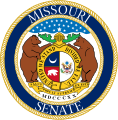Need and Creation of "Seal of State" Law
Mary Miller Smiser gives the background for creating the State Seal: "Upon the admission of Missouri into the Union the Constitution provided for a 'Seal of State,' which should not be subject to change. The Journals of the First Session of the General Assembly show that the members of the House and Senate failed repeatedly in their effort to secure a suitable design for a 'Seal of State.' [3]
"When the Second Session convened November 6, 1821, Governor McNair, in reading his message to the General Assembly, said: 'Considerable inconvenience daily arises from want of a `Seal of State' and I deem it proper to remind you of the necessity of supplying the deficiency at the present session.' [4]
"On reading the Journals of the House and Senate for the Second Session of the First General Assembly, which lasted a little over two months, we find the Senate took no part in making provision for a 'Seal of State.' The whole matter was delegated to the House, in whose hands it soon became a 'Howard County responsibility.' The day following the reading of Governor McNair's message, Duff Green, representative from Howard County, moved that the part of the governor's message pertaining to a 'Seal of State' be referred to a "Select Committee." [5] [6]
The seal was adopted on January 11, 1822. [7] The initial 1822 law describing Missouri's "Seal of State" is as follows:
The device for an armorial achievement for the State of Missouri shall be as follows, to wit: Arms, parted per pale, on the dexter side; gules, the white or grizzly bear of Missouri, passant guardant, proper on a chief engrailed; azure, a crescent argent; on the sinister side, argent, the arms of the United States; the whole with a band inscribed with the words `United We Stand, Divided We Fall.' For the crest, over a helmet full faced, grated with six bars, or a cloud proper, from which ascends a star, argent, on an azure field, surrounded by a cloud proper. Supporters on each side, a white or grizzly bear of Missouri, rampant, guardant proper, standing on a scroll, inscribed with the motto: `Salus Populi Suprema Lex Esto,' and under the scroll the numerical letters MDCCCXX. And the great seal of the state shall be so engraved as to present by its impression the device of the armorial achievement aforesaid, surrounded by a scroll inscribed with the words, "The Great Seal of Missouri," in Roman capitals; which seal shall be in a circular form, and not more than two and a half inches in diameter. [8]
State Seal removed
Mary Smiser recounts the time the State seal was removed from the state capital during the Civil War:
"When Claiborne F. Jackson was governor he issued a proclamation declaring Missouri out of the Union, left the state capital to escape capture by federal troops and took with him the great seal. That was the original, not the facsimile used in the press to stamp public documents. It has been kept under lock and key in the office of the secretary of state. Governor Jackson died in 1862 and was succeeded by Thomas C. Reynolds then a resident of St. Louis. It was suggested to him that he should return it to the state.
"'I will return it,' replied the governor, 'whenever Missouri has a governor legally elected at the polls.' No persuasion could move him. When Joseph W. McClung, Republican, was elected governor in 1868, defeating John S. Phelps, the Democratic nominee, Governor Reynolds decided to return the great seal. The seal has been in use ever since." [17]







